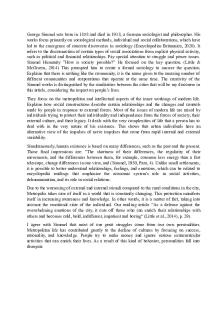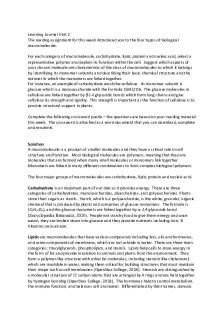Learning Journal Unit 3 Macroeconomics BUS1104 PDF

| Title | Learning Journal Unit 3 Macroeconomics BUS1104 |
|---|---|
| Course | Macroeconomics |
| Institution | University of the People |
| Pages | 2 |
| File Size | 77.8 KB |
| File Type | |
| Total Downloads | 41 |
| Total Views | 137 |
Summary
In Chapter 7, the discussion was around the aggregate demand and supply model. We can see that the aggregate demand curve slopes downward, indicating that the aggregate quantity of goods and services demanded tends to rise as the price level falls and falls as the price level rises. The wealth effec...
Description
In Chapter 7, the discussion was around the aggregate demand and supply model. We can see that the aggregate demand curve slopes downward, indicating that the aggregate quantity of goods and services demanded tends to rise as the price level falls and falls as the price level rises. The wealth effect for consumption, the interest rate effect for investment and the international trade effect for net exports all contribute to the negative relationship between the price level and the number of goods and services demanded. We also looked at the factors that can cause the aggregate demand curve to shift. The aggregate demand curve generally shifts by a multiple of the initial amount by which the component causing it to shift changes (Rittenberg & Tregarthen, 2012, P.312). The aggregate expenditures model was presented in Chapter 13. At a given price level, aggregate expenditures are the sum of planned levels of consumption, investment, government purchases, and net exports. The aggregate expenditures model connects aggregate expenditures to real GDP levels (Rittenberg & Tregarthen, 2012, P.564). These chapters have introduced me to concepts used to calculate and comprehend the GDP. I chose questions 2, 5, and 6 in chapter 7. 2. Explain why a change in one component of aggregate demand will cause the aggregate demand curve to shift by a multiple of the initial change. Like most typical demand curves, the aggregate demand curve slopes downward from left to right. As the price of goods and services rises or falls, demand rises or falls along the curve. Furthermore, the curve can shift due to changes in the money supply or tax rate increases and decreases (What Is Aggregate Demand?, 2021). The AD-like demand curve for individual goods is downward sloping, implying that the price level and the quantity demanded of real GDP have an inverse relationship. The shift in the AD indicates that the quantity demanded of real GDP has decreased at the same price levels. Changes in the AD result from changes in demand for any component of real GDP, changes in demand for goods and services, changes in investment spending, changes in government demand for goods and services, and changes in net exports. AD will shift to the left if consumers decide to reduce their spending on all goods and services.
5. Give three reasons for the downward slope of the aggregate demand curve. For the following reasons, the aggregate demand curve will have a downward slope: (a). Increased Spending Power: When the price level falls, consumers are more likely to have
more disposable income and thus spend more. For example, if the price level falls by 20%, $10,000 in wealth will buy more goods and services than it would have if the price level had not fallen. People will increase their consumption as their wealth rises (Rittenberg & Tregarthen. T, 2012). (b). Change in Net Export: For example, if a country's price level falls, the country's goods become more competitive, resulting in higher exports. Lower price levels in an economy lower the prices of its goods and services relative to goods and services produced elsewhere. A lower price level makes a country's goods more appealing to foreign buyers, resulting in increased exports. (c) Lower Interest Rate: When prices fall, interest rates typically fall, resulting in higher aggregate demand. A lower price level reduces the demand for money because it takes less money to buy a given quantity of goods. As a result, when the price level is low, interest rates fall, making borrowing by firms to build factories or buy equipment and other capital more appealing. 6. “When the price level falls, people’s wealth increases. When wealth increases, the real volume of consumption increases. Therefore, a decrease in the price level will cause the aggregate demand curve to shift to the right.” Do you agree? Explain. I believe that as consumers' wealth grows, they are more likely to spend more money. The more likely they are to spend, the more the aggregate demand curve shifts to the right. I agree with the assertion. When the price level rises, the purchasing power of the currency decreases. This reduces desired consumption, causing aggregate demand to shift to the left.
References Rittenberg, L. and Tregarthen,T. (2012). Macroeconomics principles v.2.0. Licensed under Creative Commons by-nc-sa 3.0 (https://creativecommons.org/licenses/by-nc-sa/3.0/ What Is Aggregate Demand? (2021, October 20). Investopedia. https://www.investopedia.com/terms/a/aggregatedemand.asp...
Similar Free PDFs

Learning Journal Unit 3
- 2 Pages

Learning journal unit 3
- 2 Pages

UNIT 3 Learning Journal
- 2 Pages

LJ3 learning journal unit 3
- 2 Pages

Learning journal unit 4
- 3 Pages

Learning Journal Unit 1
- 2 Pages

Learning Journal Unit 8
- 2 Pages

Learning Journal unit 7
- 2 Pages

Learning Journal Unit 8
- 2 Pages

Learning Journal Unit 6
- 1 Pages

Learning Journal Unit 2
- 2 Pages

Learning Journal. Unit 6
- 3 Pages

Learning Journal Unit 2
- 2 Pages
Popular Institutions
- Tinajero National High School - Annex
- Politeknik Caltex Riau
- Yokohama City University
- SGT University
- University of Al-Qadisiyah
- Divine Word College of Vigan
- Techniek College Rotterdam
- Universidade de Santiago
- Universiti Teknologi MARA Cawangan Johor Kampus Pasir Gudang
- Poltekkes Kemenkes Yogyakarta
- Baguio City National High School
- Colegio san marcos
- preparatoria uno
- Centro de Bachillerato Tecnológico Industrial y de Servicios No. 107
- Dalian Maritime University
- Quang Trung Secondary School
- Colegio Tecnológico en Informática
- Corporación Regional de Educación Superior
- Grupo CEDVA
- Dar Al Uloom University
- Centro de Estudios Preuniversitarios de la Universidad Nacional de Ingeniería
- 上智大学
- Aakash International School, Nuna Majara
- San Felipe Neri Catholic School
- Kang Chiao International School - New Taipei City
- Misamis Occidental National High School
- Institución Educativa Escuela Normal Juan Ladrilleros
- Kolehiyo ng Pantukan
- Batanes State College
- Instituto Continental
- Sekolah Menengah Kejuruan Kesehatan Kaltara (Tarakan)
- Colegio de La Inmaculada Concepcion - Cebu


